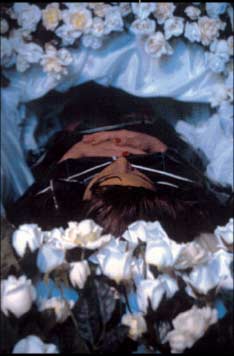 |
 |
 |
 |
 |
 |
 |
 |
 |
 |
 |
 |
 |
 |
 |
 |
 |
 |
 |
 |
 |
 |
 |
After the Tex-Mex singer Selena was shot and killed by a colleague
last year, and the People Magazine bearing her image sold more copies than
any other issue in the publication’s history, I began to ask myself
why Latino cultures in the north and south are so fasci nated with female
creativity once it has been forever silenced. Clearly, there are aspects
of Catholicism that celebrate female suf fering as a virtue, and which have
often been used to encourage Latin women to accept mental and physical abuse;
however it seems to me that the stakes are raised when female artists are
involved in the equa tion, in that the very ambivalence toward ceding access
to women in public life expresses itself perfectly in the sharp change in
atti tudes toward women artists before and after their death. It is almost
as if a violent death makes them more acceptably feminine. |
 |
power she held over her people even after
her death; and Sor Juana, who was forced to set down her pen by the Church hierarchy,
and then sent to certain death as a nurse to plague victims in la Nueva España.
I have decided to develop a performance that links these stories. |
 |
 |
 |
 |
 |
For this performance, I converted galleries into funeral parlors
and held a series of wakes. Each wake was dedicated to one of the abovementioned
artists. I appeared as a different personage each day. Texts around the
coffin would offer pertinent details from each artist’s life, and
one written statement from each artist would serve as the textual centerpiece.
Sound effects for each day, a loop of music, prayers, and speeches, would
be emitted from speakers lodged within the coffin itself. Audience members
would be encouraged to respond by writing statements and leaving their own
offerings. |
 |
 |
 |
 |
 |
As I began to think about this phenomenon, many other examples came
to mind; the famous case of Cuban artist Ana Mendieta, whose artwork skyrocketed
in value after she “fell” from the window of the apartment she
shared with her husband Carl Andre; Cuban filmmaker Sara Gomez, who was
never permitted to explore the social issues that interested her when working
at the Cuban Film Institute, but who was practically canonized by her colleagues
after her mysterious death from an asthma attack; Frida Kahlo, who was never
properly recognized during her lifetime, only to become the most well known
symbol of female artistic martyrdom in the 1980’s; Evita Peron, whose
corpse was hidden from view for several years by the Argentine military
who feared the |
 |
 |
 |
 |
 |
 |
|
I have explored the techniques of living dioramas in sev eral earlier
performances, including Mexarcane , Two Undiscovered Amerindians, and La
Chavela Realty . I am particularly interested in this performance method,
as it enables me to play with the border between the real and the fictional,
and between appearance and real ity. With this particular performance, all
the feelings of the uncanny that direct encounters with the dead often produce
would become the starting point for an emotional and intellectual explora
tion of the issues I raise. |
 |
 |
 |
 |
 |
 |
 |
 |
 |
 |
 |
 |
 |
 |
 |
 |
 |
 |
 |
 |
 |
 |
|









